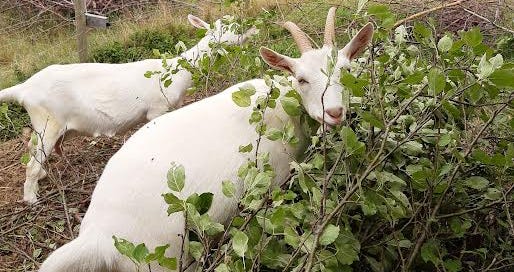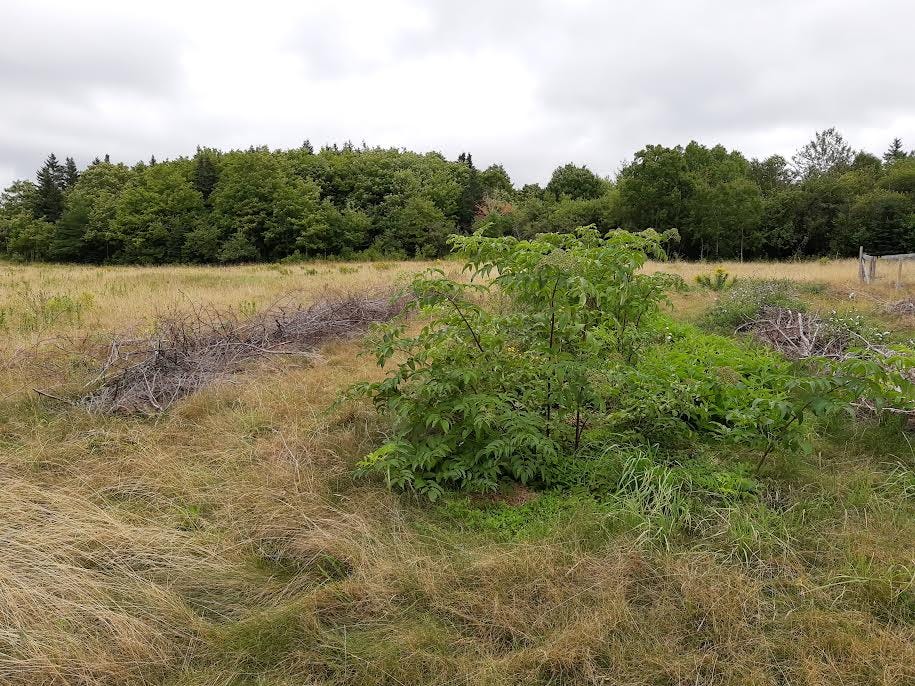In praise of brush piles and woody debris. (Part 1)
Establishing food growing zones and regenerating soil on your homestead, farm, and in your backyard!
Turning tree branches and other woody debris into windrows and brush fences is one of my favourite activities to do on our Cape Breton homestead. Fortunately, I have an abundance of brush to work with, thanks to the daily feeding regime of my two goats — Willow and Lucy!
All through the summer and well into the fall — along with their daily allotment of hay — my two dairy goats get a big pile of leafy deciduous branches or fresh-cut brush. Goats are naturally browsing ruminants, and left to their own devices would happily cruise around the whole of our acreage nibbling on a bit of this rosebush and that fruit tree, and from time-to-time a blade of grass. Too be sure, goats do not (and should not) eat anything or everything. For example, I never feed the goats cut branches from wild cherry trees. Wilted cherry leaves are somewhat toxic to goats — although I notice they will take a nibble from cherry on their own, if we are out for a walk in the back meadow.
In the winter, along with their hay, Willow and Lucy get a daily bundle of coniferous tree branches — their favourite being balsam fir, although by early spring they also enjoy white spruce. I rarely feed them white pine —they don’t seem to like it — and NEVER EVER Eastern red cedar/juniper (Juniperus virginiana), which is an abortient for goats and sheep.
As you can well imagine, this daily routine results in the accumulation of a very large stockpile of de-leafed and debarked branches —brush!
In keeping with the permaculture principle #8 —Integrate rather than Segregate — I do my best to “set things up to work together and make connections between different elements of (our) homestead so that they can benefit each other through their interactions with one another”, https://thehouseandhomestead.com/principles-of-permaculture). So, while I am providing my goats with low-cost, nutrient-dense, and interesting-to-their-palate fodder, I am also harvesting their breakfast from an area on our property where I am implementing a forest garden project; or opening up space in the canopy to release tree seedling growth on the forest floor; or perhaps making a trail.
Lately I have been practicing my daily brush harvesting routine on a one acre wooded section of our land that is essentially a thicket of wild apple trees. While a few of these apple trees produce delicious and good keeping fruit, most do not.
After four years of paying attention to what trees produce delicious tasting fruit — Permaculture principle #1: Observe and Interact with Nature: “Observe the land and the systems that are already functioning naturally to help you decide how to make these natural systems work for you” (https://thehouseandhomestead.com/principles-of-permaculture) — I have have a pretty good idea of which apple trees I would like to keep and enhance their growth potential, and which trees I want remove.
Creating more space in the forested canopy for my preferred apple trees increases their access to sunlight. By increasing their capacity to photosynthesize, the trees capture carbon from the atmosphere and build their woody bodies. All the while these same trees are feeding the soil micro-biome through their mycorrhizal and bacterial root relationships. Winner, Winner!!!!
Clearing space in the tree canopy also promotes air circulation that helps mitigate airborne fungal and bacterial diseases. And now that more sunlight reaches the forest floor, I have increased opportunities to grow other shade tolerant, food and medicine producing botanicals.
Now, I don’t mind admitting, I like a good bonfire as much as the next person. But I rarely burn brush piles. And I don’t burn them for what I believe are some really good reasons. Instead I use this accumulated brush and woody debris to make windrows. You will find these vernacular wooden structures popping up on our homestead where I want to make new gardens, plant or protect tender fruit-bearing bushes, or create a sense of demarcation or containment. These brush-windrows provide many important ecological and economical benefits that I want to see more of in this world. Some of these benefits include:
1/ Increasing nesting habitat for song sparrows (Melospiza melodia) and other small birds that seek out densely foliated shrubs and thickets for shelter and safety, especially during nesting season.
2/ Increasing critical habitat for native bees and other invertebrates.
3/ Increasing habitat for small rodents, which supports healthy populations of hawks and owls.
4/ Increasing habitat for snakes, toads and salamanders.
5/ Creating windbreaks that decrease soil erosion and modify surface ground temperature. The resultant microclimate-zones increase the diversity of botanicals I am able to grow, here in the short-season of Cape Breton.
5/ Slowing down soil surface evaporation — this will become increasingly important in this ‘new-normal’ of droughty summers we are experiencing. I have noticed that in the spring snow will remain under the brush windrows long after it has disappeared in the surrounding field.
6/ Increasing and diversifying nutrient capacity in the soil that supports the micro-biome and builds soil humus.
While this list could continue, I believe that I have given you a good idea how gratifying building brush windrows can be.
In the next edition of this short series on brush and woody debris we will look at some of the scientific research into the benefits, and take a short picture tour of what’s involved in harvesting and utilizing woody debris in landscape designs and soil regeneration. I hope you will join me.






Always informative! It's great to realize that a picture perfect field isn't always creature, plant and human perfect.
This series is so good! I'm learning so much from you.